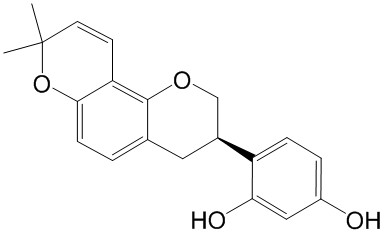Home
Products
Glabridin



| Product Name | Glabridin |
| Price: | $31 / 20mg |
| Catalog No.: | CN05500 |
| CAS No.: | 59870-68-7 |
| Molecular Formula: | C20H20O4 |
| Molecular Weight: | 324.37 g/mol |
| Purity: | >=98% |
| Type of Compound: | Flavonoids |
| Physical Desc.: | Powder |
| Source: | The roots of Glycyrrhiza glabra L. |
| Solvent: | Chloroform, Dichloromethane, Ethyl Acetate, DMSO, Acetone, etc. |
| SMILES: | Oc1ccc(c(c1)O)[C@@H]1COc2c(C1)ccc1c2C=CC(O1)(C)C |
| Contact us | |
|---|---|
| First Name: | |
| Last Name: | |
| E-mail: | |
| Question: | |
| Description | Glabridin is a natural isoflavan from Glycyrrhiza glabra, binds to and activates PPARγ, with an EC50 of 6115 nM. Glabridin exhibits antioxidant, anti-bacterial, anti-nephritic, anti-diabetic, anti-fungal, antitumor, anti-inflammatory, antiosteoporotic, cardiovascular protective, neuroprotective and radical scavenging activities[1][2]. |
| Target | PPARγ:6.1 μM (EC50) |
| In Vitro | Glabridin binds to and activates PPARγ, with an EC50 of 6115 nM[1]. Glabridin (40, 80 μM) inhibits the proliferation of SCC-9 and SAS cell lines in a dose- and time-dependent manner after treatment for 24 and 48 h[2]. Glabridin (0-80 μM) also induces apoptosis, causes Sub-G1 cell cycle arrest in SCC-9 and SAS cell lines[2]. Glabridin (0, 20, 40, and 80 μM) dose-dependently activates caspase-3, −8, and −9 and increases PARP cleavage, significantly phosphorylates ERK1/2, JNK1/2, and p-38 MAPK in SCC-9 cells[2]. |
| In Vivo | Glabridin (50 mg/kg, p.o. once daily) shows potent anti-inflammatory activity, ameliorates the inflammatory alterations induced by Dextran sodium sulphate (DSS) in rats[3]. |
| Density | 1.3±0.1 g/cm3 |
| Boiling Point | 518.6±50.0 °C at 760 mmHg |
| Flash Point | 267.4±30.1 °C |
| Exact Mass | 324.136169 |
| PSA | 58.92000 |
| LogP | 4.26 |
| Vapour Pressure | 0.0±1.4 mmHg at 25°C |
| Storage condition | room temp |